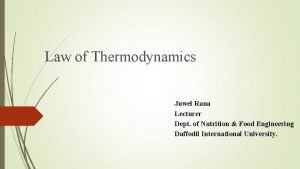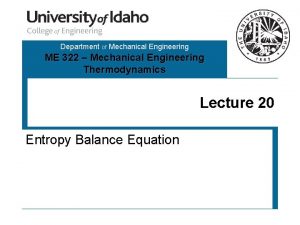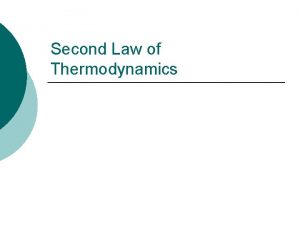Chap20 Entropy and the Second Law of Thermodynamics




- Slides: 4

Chap-20: Entropy and the Second Law of Thermodynamics Aging process, breaking an egg, baking a pizza —these one-way processes are irreversible, meaning that they cannot be reversed by means of only small changes in their environment. The key to understanding why one-way processes cannot be reversed involves a quantity known as entropy. For example, if you were to wrap your hands around a cup of hot coffee, you would be astonished if your hands got cooler and the cup got warmer. That is obviously the wrong way for the energy transfer, but the total energy of the closed system (hands +cup of coffee) would be the same as the total energy if the process had run in the right way. Thus, changes in energy within a closed system do not set the direction of irreversible processes. Rather, that direction is set by another property —the change in entropy ΔS of the system. If an irreversible process occurs in a closed system, the entropy S of the system always increases; it never decreases.

Change in Entropy, S is a state property like p, V, T, and E. Unit for entropy: J/K The Second Law of Thermodynamics: If a process occurs in a closed system, the entropy of the system increases for irreversible processes and remains constant for reversible processes. It never decreases.

Force Due to Entropy causes a rubber band or balloon What to resist stretching?

Problem 55, Chap-20 A 600 g lump of copper at 80. 0°C is placed in 70. 0 g of water at 10. 0°C in an insulated container. (ccu = 386 J/(kg. K) and cw = 4187 J/(kg. K)) (a) What is the equilibrium temperature of the copper–water system? What entropy changes do (b) the copper, (c) the water, and (d) the copper–water system undergo in reaching the equilibrium temperature







